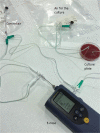Using the Electronic Nose to Identify Airway Infection during COPD Exacerbations
- PMID: 26353114
- PMCID: PMC4564204
- DOI: 10.1371/journal.pone.0135199
Using the Electronic Nose to Identify Airway Infection during COPD Exacerbations
Abstract
Background: The electronic nose (e-nose) detects volatile organic compounds (VOCs) in exhaled air. We hypothesized that the exhaled VOCs print is different in stable vs. exacerbated patients with chronic obstructive pulmonary disease (COPD), particularly if the latter is associated with airway bacterial infection, and that the e-nose can distinguish them.
Methods: Smell-prints of the bacteria most commonly involved in exacerbations of COPD (ECOPD) were identified in vitro. Subsequently, we tested our hypothesis in 93 patients with ECOPD, 19 of them with pneumonia, 50 with stable COPD and 30 healthy controls in a cross-sectional case-controlled study. Secondly, ECOPD patients were re-studied after 2 months if clinically stable. Exhaled air was collected within a Tedlar bag and processed by a Cynarose 320 e-nose. Breath-prints were analyzed by Linear Discriminant Analysis (LDA) with "One Out" technique and Sensor logic Relations (SLR). Sputum samples were collected for culture.
Results: ECOPD with evidence of infection were significantly distinguishable from non-infected ECOPD (p = 0.018), with better accuracy when ECOPD was associated to pneumonia. The same patients with ECOPD were significantly distinguishable from stable COPD during follow-up (p = 0.018), unless the patient was colonized. Additionally, breath-prints from COPD patients were significantly distinguished from healthy controls. Various bacteria species were identified in culture but the e-nose was unable to identify accurately the bacteria smell-print in infected patients.
Conclusion: E-nose can identify ECOPD, especially if associated with airway bacterial infection or pneumonia.
Conflict of interest statement
Figures




Similar articles
-
Identification of airway bacterial colonization by an electronic nose in Chronic Obstructive Pulmonary Disease.Respir Med. 2014 Nov;108(11):1608-14. doi: 10.1016/j.rmed.2014.09.008. Epub 2014 Sep 19. Respir Med. 2014. PMID: 25269711
-
An electronic nose in the discrimination of patients with non-small cell lung cancer and COPD.Lung Cancer. 2009 May;64(2):166-70. doi: 10.1016/j.lungcan.2008.08.008. Epub 2008 Oct 1. Lung Cancer. 2009. PMID: 18834643
-
Discrimination between COPD patients with and without alpha 1-antitrypsin deficiency using an electronic nose.Respirology. 2011 Nov;16(8):1258-64. doi: 10.1111/j.1440-1843.2011.02047.x. Respirology. 2011. PMID: 21883674
-
The Role of Electronic Noses in Phenotyping Patients with Chronic Obstructive Pulmonary Disease.Biosensors (Basel). 2020 Nov 11;10(11):171. doi: 10.3390/bios10110171. Biosensors (Basel). 2020. PMID: 33187142 Free PMC article. Review.
-
Exhaled volatile organic compounds associated with chronic obstructive pulmonary disease exacerbations-a systematic review and validation.J Breath Res. 2025 Mar 11;19(2). doi: 10.1088/1752-7163/adba06. J Breath Res. 2025. PMID: 39999477
Cited by
-
Sensors for detecting pulmonary diseases from exhaled breath.Eur Respir Rev. 2019 Jun 26;28(152):190011. doi: 10.1183/16000617.0011-2019. Print 2019 Jun 30. Eur Respir Rev. 2019. PMID: 31243097 Free PMC article. Review.
-
Pilot Study: Detection of Gastric Cancer From Exhaled Air Analyzed With an Electronic Nose in Chinese Patients.Surg Innov. 2018 Oct;25(5):429-434. doi: 10.1177/1553350618781267. Epub 2018 Jun 18. Surg Innov. 2018. PMID: 29909757 Free PMC article.
-
Exhaled volatile organic compounds and lung microbiome in COPD: a pilot randomised controlled trial.ERJ Open Res. 2021 Oct 4;7(4):00253-2021. doi: 10.1183/23120541.00253-2021. eCollection 2021 Oct. ERJ Open Res. 2021. PMID: 34616836 Free PMC article.
-
Electronic Nose Technology in Respiratory Diseases.Lung. 2017 Apr;195(2):157-165. doi: 10.1007/s00408-017-9987-3. Epub 2017 Feb 25. Lung. 2017. PMID: 28238110 Review.
-
A systematic review of the diagnostic accuracy of volatile organic compounds in airway diseases and their relation to markers of type-2 inflammation.ERJ Open Res. 2021 Aug 31;7(3):00030-2021. doi: 10.1183/23120541.00030-2021. eCollection 2021 Jul. ERJ Open Res. 2021. PMID: 34476250 Free PMC article.
References
-
- Anthonisen NR, Manfreda J, Warren CP, Hershfield ES, Harding GK, Nelson NA. Antibiotic therapy in exacerbations of chronic obstructive pulmonary disease. Ann Intern Med. 1987. February;106(2):196–204. - PubMed
-
- Celli BR, MacNee W. Standards for the diagnosis and treatment of patients with COPD: a summary of the ATS/ERS position paper. Eur Respir J. 2004. June;23(6):932–46. - PubMed
-
- Vestbo J, Hurd SS, Agusti AG, Jones PW, Vogelmeier C, Anzueto A, et al. Global strategy for the diagnosis, management, and prevention of chronic obstructive pulmonary disease: GOLD executive summary. Am J Respir Crit Care Med. 2013. February 15;187(4):347–65. 10.1164/rccm.201204-0596PP - DOI - PubMed
Publication types
MeSH terms
Substances
LinkOut - more resources
Full Text Sources
Other Literature Sources
Medical

